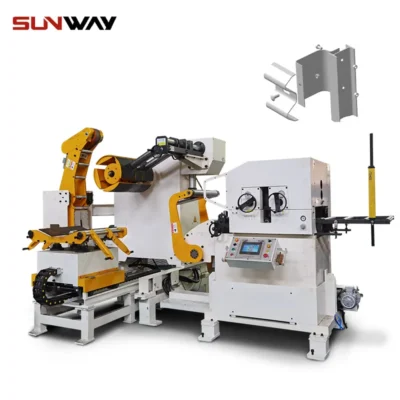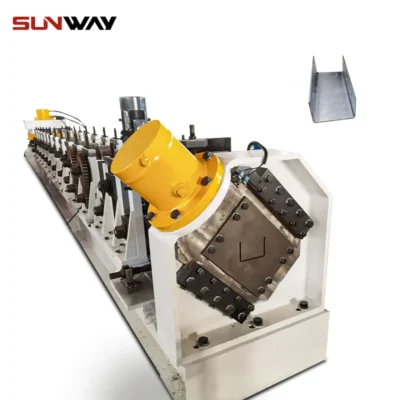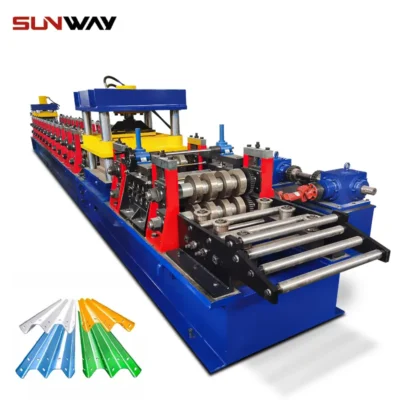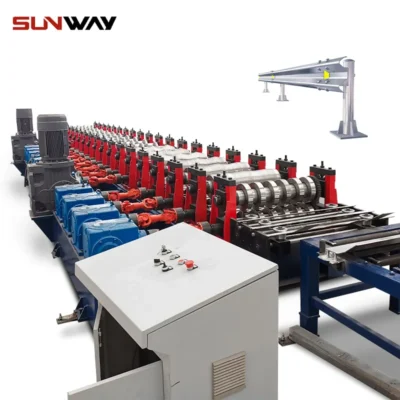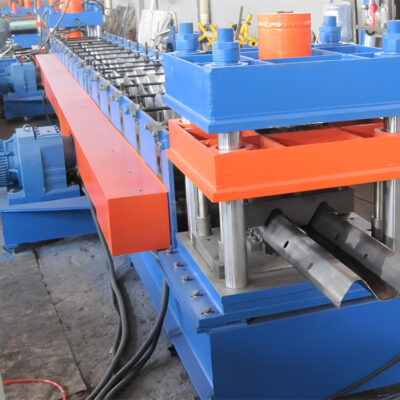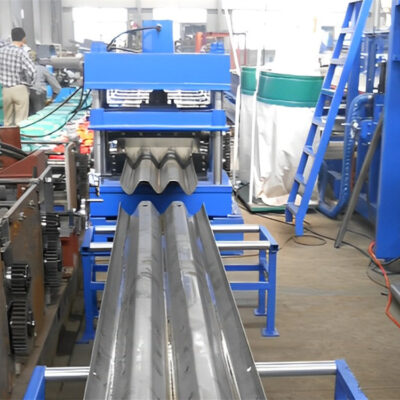Composite floor deck roll forming machines are specialized lines designed to cold-form metal coils into profiled steel floor decks for concrete slabs in buildings. This automated process efficiently produces finished floor decks.
This comprehensive guide provides everything you need to know about composite floor deck roll forming equipment, including:
Introduction to Composite Floor Deck Roll Forming
Roll forming shapes flat strip steel through a series of progressive dies into trapezoidal, re-entrant or other profiles for composite floor decks.
Benefits:
- Highly efficient continuous forming
- Quality and uniformity of decks
- Minimal material waste
- Automated mass production
- Flexibility to change profiles
Main Components:
- Coil payoff reel
- Feed rollers
- Forming stations
- Punching unit
- Shearing cutoff
- Control system
Latest composite floor deck roll formers deliver robust performance, precision and reliability ideal for deck production.
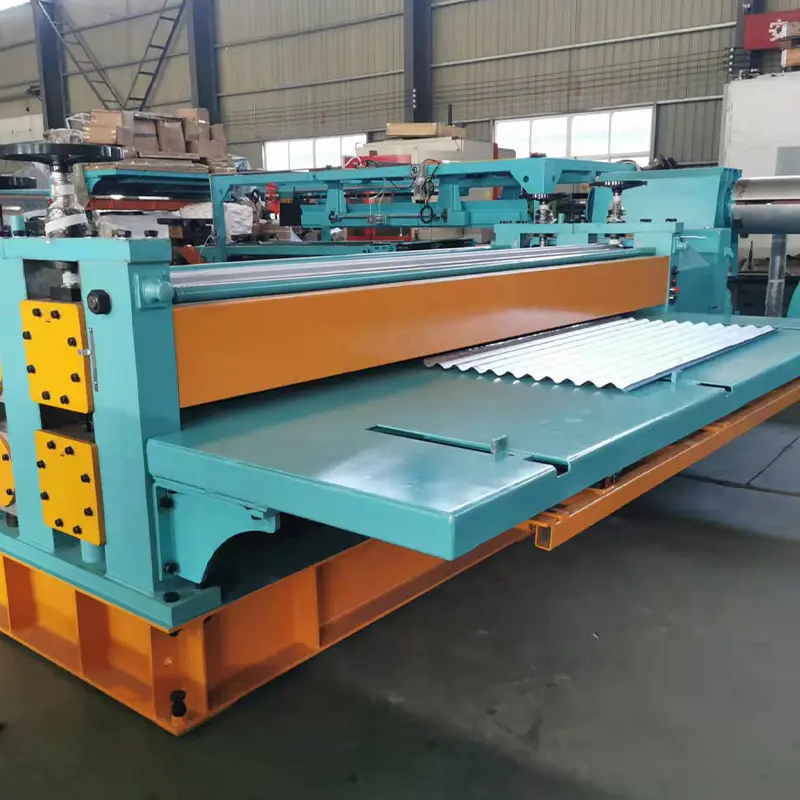
Types of Composite Floor Deck Roll Forming Machine
Composite floor deck roll forming machines come in several configurations:
| Types | Descriptions |
|---|---|
| Mechanical | Basic machines with mechanical drives |
| Servo-motor | Advanced programmable servo motor drives |
| All-electric | Energy efficient AC motors |
| Hydraulic | Powered by hydraulic power packs |
| Automatic | Fully automated infeed and cutoff |
| Portable | Compact mobile roll formers |
Modern servo-controlled roll formers with automated features provide the best accuracy and productivity.
Floor Deck Profiles Produced
Common profiles that can be roll formed include:
- Formlok – Re-entrant wide ribbed deck
- Multideck – Trapezoidal profile with intermediate ribs
- Regallok – Wider trapezoidal deck with re-entrant bottom
- Insulated Comdek – Foam-filled deck
- Curved decks – For special architectural designs
- Embossing – Aesthetic patterns
With quick die changeover, lines can be rapidly switched between different deck profiles.
Floor Deck Materials Used
Common materials roll formed into composite floor decks:
- Galvanized steel
- Zinc-coated steel
- Pre-painted steel
- Stainless steel
- Fibergrate – FRP deck
- Aluminum
Steel offers the optimal combination of strength, weight, span capability and cost.
Composite Floor Deck Roll Forming Process
The production sequence involves:
- Loading a steel coil into the feed system
- Feeding the strip through progressive roll forming stations
- Gradually cold-forming the target deck profile
- Punching any required holes for utilities or installation
- Shearing the deck sheets to specified length
- Conveying finished deck sections for stacking
Automated servo-motor controls precisely coordinate material movement through the in-feed, forming, punching, shearing and exit conveyor for rapid production.
Composite Floor Deck Roll Former Specifications
Typical specifications can be customized:
| Parameters | Range |
|---|---|
| Forming Speed | 10 – 30 m/min |
| Strip Width | 600 – 1200 mm |
| Thickness | 0.7 – 2 mm |
| Deck Height | 30 – 200 mm |
| Rib Spacing | 50 – 250 mm |
| Sheet Length | 2 – 15 m |
| Power | 15 – 50 kW |
| Automation | Manual to Fully Automatic |
Choosing appropriate strip parameters, deck dimensions and speed capacity is vital.
Standards for Composite Floor Decks
Major standards include:
- ASCE 3-91 – Cold formed steel design standard
- ASTM A653 – Steel sheet Zinc-coated by hot dip process
- CAN S16 – Strength design / limit states design of steel structures
- ASCE 7 – Minimum design loads for buildings and structures
- SFA 9500 – Roll formed steel floor deck design manual
- FM Global – Factory Mutual – fire safety standards
Compliance is critical for performance, quality and fire safety.
Composite Floor Deck Roll Forming Machine Manufacturers
Leading global manufacturers of floor deck roll forming lines include:
| Company | Location | Description | Pricing |
|---|---|---|---|
| Metform | USA | Custom high capacity lines | $$ to $$$ |
| Behemoth | Canada | Robust heavy duty lines | $$ to $$$ |
| Zhongrui | China | Affordable standard lines | $ to $$ |
| Zeman | Czech | Advanced European lines | $$$ |
| Its | Korea | Value engineered lines | $ to $$ |
Pricing Considerations:
- Production speed and automation
- Line width capacity
- Quick changeover features
- Brand, quality and support services
- Customization of specifications
Partner with qualified manufacturers providing properly engineered equipment matched to your production needs.
Buying Considerations for Floor Deck Lines
Important factors when investing in composite floor deck roll forming equipment:
- Required deck specifications and profiles
- Production volume and speed goals
- Width capacity for coil stock
- Automation capabilities preferred
- Quick changeover functionality between profiles
- Precision, accuracy and reliability needs
- Available production space and layout
- Power supply requirements
- Operator skill level
- Ongoing service and support
Clarifying key requirements will help identify appropriate roll former specifications and capabilities.
Installing and Operating Floor Deck Roll Forming Machines
Proper installation and operation procedures include:
- Stable, level and smooth foundation
- Adequate space around the equipment
- Securing stations and verifying alignments
- Electrical, pneumatic and hydraulic connections
- Integrating safety features and protocols
- Programmed setup and trials for each profile
- Preventive maintenance and lubrication
- Adhering to all safety procedures
Thorough installation, commissioning and maintenance is key for maximizing production uptime and achieving a long service lifetime.
Benefits of Composite Floor Deck Roll Forming Machine
Key advantages over other forming methods:
- Continuous high speed production from coil
- Consistent and precision deck dimensions
- Minimal material waste
- Lower operational costs
- Flexible, quick changeovers between profiles
- Safer enclosed process than open sheet fabrication
- Automated process ideal for large volume production
- Deck integration possible with other prefab techniques
Roll forming provides an efficient and economical deck manufacturing method.
Limitations of Composite Floor Deck Roll Forming
Some limitations include:
- High initial capital expenditure
- Substantial production volumes required for ROI
- Dedicated tooling for each profile
- Size constraints – width, bend radii etc.
- Material thickness and strength capabilities
- Secondary operations like punching may be needed
Other processes like press braking or stamping may suit lower volume production.
Cost Analysis for Roll Formed Floor Decks
- Equipment – $100,000 to $750,000
- Tooling per profile – $5,000 to $15,000
- Material coil – Varies based on steel specs
- Operating costs – Labor, maintenance, utilities
- Amortized equipment cost – Based on yearly production rate
- Secondary processing – Punching, stiffening etc.
- Logistics – Inbound coils, outbound deck delivery
High production levels provide lowest cost per square foot and rapid payback on equipment.
Future Outlook for Composite Floor Deck Roll Forming
The future outlook for composite floor deck roll forming is positive:
- Ongoing construction industry growth worldwide
- Transition from manual fabrication to automated lines
- Declining equipment costs over time
- Increasing line speed, precision, efficiency and flexibility
- Quick-change tooling enabling faster changeovers
- Tighter integration with upstream coil processing and downstream fabrication
- Overall market maturation and consolidation among manufacturers
With technology improvements, roll formed composite floor decks will continue gaining market share.
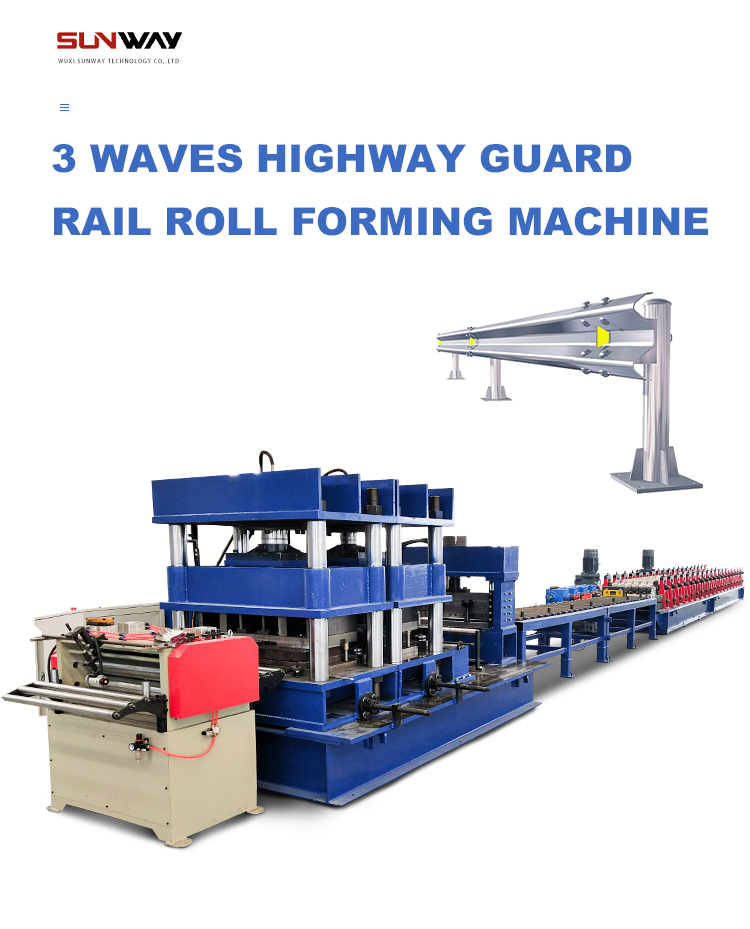
FAQ
Q: What materials can be roll formed into floor decks?
A: Most commonly galvanized steel and zinc-coated steel coils. Other options include stainless steel, painted steel and aluminum.
Q: What thickness coils are typically formed into decks?
A: Standard thicknesses range from 0.7mm to 2mm. Maximum depends on equipment capacity.
Q: How long does it take to form each deck sheet?
A: On high speed lines producing 6m+ lengths, decks can be formed in under 1 minute.
Q: How are roll formed floor decks cut to length?
A: A shearing press built into the line cuts decks at the production speed.
Q: What expertise is required to operate a deck roll former?
A: Machine operators require training. Skilled technicians needed for programming, maintenance and troubleshooting.
Q: What safety equipment is mandatory?
A: Guards, e-stops, interlocks, automatic shutdowns, and strict operating procedures.
Q: How much does a composite floor deck roll forming line cost?
A: Equipment costs range from $100k to $750k+, depending on the production speed, width, automation level, and features.
Q: How much does tooling cost for each deck profile?
A: Roll forming tooling typically costs $5k to $15k per profile set, based on size and complexity.
Q: How long does it take to changeover between profiles?
A: With quick change tooling, profile changeover takes 15-45 minutes typically.
Q: Can custom deck profiles be produced?
A: Yes, custom tooling allows production of specialized proprietary deck designs.
Frequently Asked Questions (FAQ)
1) What line speed should I target for a Composite Floor Deck Roll Forming Machine?
- For 0.9–1.2 mm galvanized steel and standard trapezoidal decks, 20–35 m/min is typical. Heavier gauges (≥1.5 mm) or dense embossing/punching may reduce effective speed to 12–20 m/min.
2) How do embossing and shear stud interaction affect deck design?
- Embossing height, pitch, and orientation increase mechanical interlock with concrete and improve shear bond. Verify emboss geometry is compatible with the project’s stud type and local composite slab design code (e.g., AISC/ASCE provisions).
3) What PLC/controls features matter most for accuracy?
- Servo length control with high-resolution encoder, flying shear synchronization, tool recipe storage, automatic roll gap presets by gauge, and closed-loop tension control between decoiler and entry guide. These deliver ±0.8–1.5 mm length tolerance at 6 m.
4) Can one machine handle both re-entrant and trapezoidal deck profiles?
- Yes, with cassette-style quick-change tooling and adjustable side guides. Plan for separate roll sets and sometimes distinct punching dies. Changeovers of 20–45 minutes are achievable with modern cassettes.
5) What standards should my finished decks comply with?
- Common references include ASTM A653/A792 (substrates), AISI S100 and AISI DDM for cold-formed design, ASCE 7 loads, FM Global approvals for fire, and project-specific shear bond/diaphragm testing per ICC-ES or local approvals. Always confirm with the structural engineer of record.
2025 Industry Trends
- Servo electrification: All-electric cutoffs and servo roll positioning reduce hydraulic maintenance and improve repeatability for composite deck lines.
- Inline QC analytics: Laser width/camber scanning and emboss depth measurement tied to SPC cut scrap 30–50% in high-mix plants.
- High-strength substrates: Wider adoption of ZM (zinc-magnesium) coated steel and higher yield strengths (≥550 MPa) for longer spans with thinner gauges.
- Digital traceability: OPC UA/MQTT connectivity sends coil ID, profile recipe, and lot data to MES/ERP for slab pour documentation.
- Sustainability: Buyers specify EPD-backed steel and low-VOC coatings; energy-optimized drives reduce kWh/ton.
2025 Performance Benchmarks for Composite Floor Deck Roll Forming
| Metric | 2022 Typical | 2025 Best-in-Class | Notes/Enablers |
|---|---|---|---|
| Line speed (trapezoidal, m/min) | 18–28 | 30–40 | Servo flying shear; optimized pass schedule |
| Length tolerance at 6 m (± mm) | 2.0 | 0.8–1.2 | High-res encoder; thermal compensation |
| Changeover (cassette, min) | 60–120 | 20–35 | Digital presets; quick couplings |
| Startup scrap (%) | 2.0–3.0 | 0.8–1.5 | Inline laser + recipe control |
| Energy use (kWh/1,000 m) | 80–110 | 55–75 | IE4 motors; VFDs; smart idle |
| Paint/galv surface defect rate (ppm) | 900–1200 | 250–500 | Low-marking rolls; tension control |
| Inline punch-to-cut sync error (ms) | 12–20 | 5–10 | Servo press; predictive sync |
Selected references and resources:
- ASTM A653/A792: https://www.astm.org
- AISI S100 Cold-Formed Steel Specification: https://www.buildusingsteel.org
- FM Approvals for roof/floor deck assemblies: https://www.fmglobal.com
- OPC Foundation (OPC UA): https://opcfoundation.org
- U.S. DOE Advanced Manufacturing (motor/drive efficiency): https://www.energy.gov/eere/amo
Latest Research Cases
Case Study 1: Inline Laser Metrology Cuts Scrap on Re-entrant Decks (2025)
Background: A North American fabricator producing 1.0–1.2 mm galvanized re-entrant decks faced 2.7% scrap due to width drift and emboss inconsistency.
Solution: Installed dual-head laser width/camber scanners, added emboss depth gauges, and linked SPC alarms to automatic roll gap trim on stands 3–6. Upgraded encoder to 1 μm resolution and implemented servo flying shear.
Results: Scrap reduced to 1.1%; length CpK improved from 1.20 to 1.75; changeover time dropped from 62 to 34 minutes; energy per 1,000 m fell 18%.
Case Study 2: High-Strength ZM-Coated Deck for Longer Spans (2024)
Background: Developer sought weight reduction for multi-story parking decks without losing span capability.
Solution: Switched from 1.2 mm AZ-coated 350 MPa steel to 1.0 mm ZM-coated 550 MPa steel; retuned roll passes and crowned low-marking rolls; validated composite action with diaphragm and shear bond tests.
Results: Deck self-weight reduced ~17%; allowable unshored span increased 8–10% depending on bay; corrosion resistance met project spec; throughput maintained at 28–32 m/min.
Expert Opinions
- Dr. Emily Hart, PE, Structural Engineer, Walter P Moore
- “For composite slabs, consistent emboss geometry and verified shear bond testing are as critical as steel grade. Shops should document lot-level deck properties for the engineer’s submittal.”
- Mark Redding, Automation Manager, The Bradbury Group
- “In 2025, connecting the roll former PLC via OPC UA and adding inline lasers is the fastest route to <1.5% scrap while holding ±1 mm length tolerance on 6 m decks.”
- Hiro Tanaka, Product Director, NIdeco Industrial Drives
- “IE4 motors with regenerative drives can trim energy per 1,000 meters by 15–25% on stop/start duty cycles—real money on high-volume composite floor deck lines.”
Practical Tools/Resources
- UBECO PROFIL (roll design for trapezoidal/re-entrant decks): https://www.ubeco.com
- COPRA RF / COPRA ProfileScan (roll design + inline profile measurement): https://www.datam.de
- AISI Cold-Formed Steel design resources: https://www.buildusingsteel.org
- FM Approvals Roof and Floor Deck Listings: https://approvalguide.com
- NIST Engineering Statistics Handbook (SPC for process capability): https://www.itl.nist.gov/div898/handbook
- DOE Motor Systems Tool and VFD guidance: https://www.energy.gov/eere/amo
- ICC Evaluation Service (ICC-ES reports on composite deck products): https://icc-es.org
Note: Validate machine specs against your target profiles, gauges, coil width, and required approvals (FM/ICC-ES). Request FAT/SAT with your coil and require documented length/width/camber and emboss measurements.
Last updated: 2025-10-21
Changelog: Added 5 FAQs; inserted 2025 trends with KPI table and sources; provided 2 recent case studies; included expert viewpoints; compiled practical tools/resources with authoritative links
Next review date & triggers: 2026-04-21 or earlier if ASTM/AISI/FMn approvals update, major OEMs release new servo cassette systems, or DOE efficiency guidance changes

